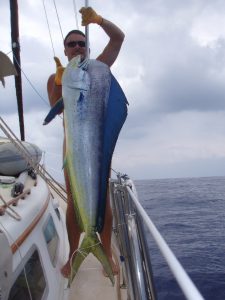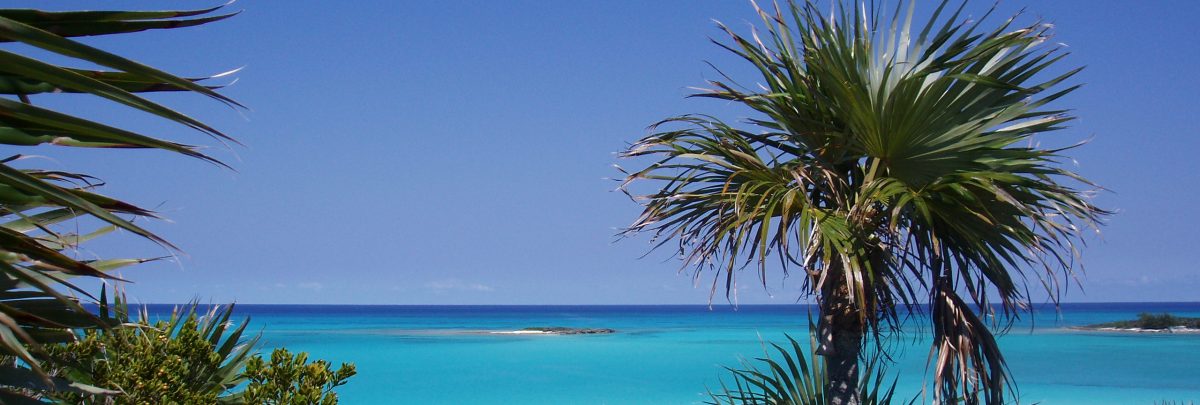Jost Van Dyke, British Virgin Islands
January 1, 2007
We are now in the British Virgin Islands!
On Wednesday, December 27th we had a brisk motor-sail in strong trades with a 5 foot constant sea from Culebra to Great St. James Island (just 1 mile east of St. Thomas and west of St. John). Great St. James is a small, unpopulated island that is part of the U.S. Virgin Islands and its western anchorage of Christmas Cove was wonderful – definitely worthy of a revisit. We were able to tuck in close to the island and had a nice sandy spot in 15 feet to drop the hook. The VHF is alive again with Big Boat traffic (Fast ferries, barges, cruise ships, yachts) and of course there are many charter boats here, which can be an amusing audio diversion.
We were anxious to get to Jost Van Dyke, BVI (“Jost” is pronounced with a “Y” and a long “o” – yoast) so we only spent one night at Christmas Cove before moving on. After going through Current Cut, which we timed to go with the current and got a nice assist from it, we entered a body of water that was very much like a washing machine. Wind and waves blasting from the east, fast ferry wakes from all sides, various currents running, and all the vacationing people on their charter boats for the week zipping around. This must be part of what is referred to as “Puke Alley”. We finally got far enough east that we turned off the engine (yay!) and sailed the remaining distance (all of 4 miles) north to Great Harbour, Jost Van Dyke.
We celebrated New Year’s Eve in Great Harbour, Jost Van Dyke, home of the infamous “Foxy’s”, along with more charterers (people that rent boats) than you could shake a stick at. And if we had had a stick on board we would have been shakin’ it. “Foxy’s” on Jost Van Dyke is on many lists as one of the top ten places in the world to celebrate New Year’s Eve. Hence, our purpose for getting here when we did. We had heard that during New Year’s Eve the harbor fills up with so many boats that you can practically walk to shore from boat to boat so we intended on getting there early and claiming our spot. That warning turned out to be not too much of an exaggeration as by the 31st there were more than 200 boats in the small harbor.
When we reached Great Harbour, JVD on Thursday, December 28th we easily found a spot to drop the hook in 15 feet of water relatively close to shore. The anchor set well in the sand and Rod put on his mask and fins to dive down and check its setting. He surfaced with the excellent report that he had never seen it set so well. We were feeling pretty good – we had a primo spot and now we could just sit back, relax and rest up for the big party at Foxy’s on the 31st. But the relaxing part didn’t last long…
By Friday afternoon the boats continued arriving, but none were leaving, as had been the routine on Thursday and early Friday. Charter boats, with their vacationing crew, tend to be on the move every day so they can visit as many anchorages as possible in their holiday week. Which, by the way, the week between Christmas and the New Year is the busiest week of the year in the Caribbean charter boat industry. Lucky us. By Saturday one boat had already dragged anchor next to us and they were too busy sucking on their beers to notice that their boat was MOVING. Not until the swimmers that were hanging on their back swim step were getting squished between their boat and the boat behind them did it register that something was amiss. They looked at me like I was a crazy lady when I was yelling “YOU’RE DRAGGING!” We continued to watch boat after boat drag because they had inadequately set their anchors. One boat had an exercise obsessed lady on the back deck and she was so focused in her second hour of calisthenics that she didn’t notice they had dragged about 75 yards and were still on the move toward other boats. Rod’s ear piercing whistle got their attention and our wild hand gestures got the point across.
We considered leaving Great Harbour on Sunday the 31st because we could see the insanity building and Rod was recovering from his head wound (details below). But dammit, we had planned on being here and had claimed our spot in the anchorage three days before these stupid people started arriving. And it would have taken us hours just to remove all the fenders we had tied around our boat! However, we did end up not even leaving the boat NYE day/night for fear of being dragged down on or ourselves dragging from all the other boats anchoring on top of us and possibly fouling our anchor (which for certain happened once and we had to reset). During that reset a boat load of non-English speaking people hit the stern of our boat while we were backing down on our anchor and they didn’t seem to grasp the implications (or our English) of damaging our windvane as the side of their Sunsail charter boat was scraping along it. We had to have anxious words with them for them to understand that they needed to move their bleepin’ boat!
Rod’s head wound: We had watched a 47′ charter catamaran anchor in front of us and observed them put out about 2:1 scope (5:1 is the norm). We were keeping an eye on it, especially when about 5 minutes after they dropped the hook they loaded into their dinghy and left the boat. We went below for a few minutes and came up to see it heading our way, which wasn’t going to take too long since it was only about 15 feet in front of us to begin with. The cruisers behind us had already seen it and had jumped in their dinghy to board the cat and start its engines. While we were fending it off the cruiser guy got on the cat and drove it away from us. Turned out there was a guy on board who was down below asleep – both he and the guy now driving the cat looked pretty surprised when sleepy guy came into the cockpit! Using their handy electric windlass they pulled up their anchor, which had now grabbed our chain. Rod jumped in the water to go under the cat and unhook our chain from their anchor. (This is now all happening right off our starboard side.) They had already pulled the anchor all the way out of the water and now their windlass was stuck and the anchor wouldn’t go back down. So Rod had to monkey himself onto the anchor to pull our chain off of it and during this maneuver as soon as the chain came free the anchor swung free and bashed him in the face. Rod was sent flying backward into the water — I thought it had knocked him unconscious so I was, um, calm challenged. His lights didn’t go completely out so he resurfaced quickly and got back on our boat. Meanwhile, two other boats are swarming in around us to anchor, Rod’s forehead is bleeding and tweety birds are flying around his head, and we have a fouled hook that we have to deal with. Needless to say, we were in no short supply of adrenaline at this point. Now you can imagine our state of mind when that boat wouldn’t get off our stern and didn’t seem to comprehend the damage they were nearly causing to our boat/home. It was as if they were thinking “Hey, relax man, have a drink, you’re on vacation.” Shaw.
It took many hours for our nerves to settle down after all this. Rod’s head is okay – he had a big goose egg knot with the skin split in the middle, but no stitches were required. Good thing, because my suturing abilities might have left a scar.
Even though we didn’t go ashore for the festivities that night we enjoyed sitting on the foredeck listening to the live music from Foxy’s – which stayed live until 5am. It was a warm evening, we shared a nice kiss at midnight under the bright stars, and the boats continued to drag around us.
Hope everyone had a safe closing to 2006 and we wish you all the best in 2007.
Happy New Year!

